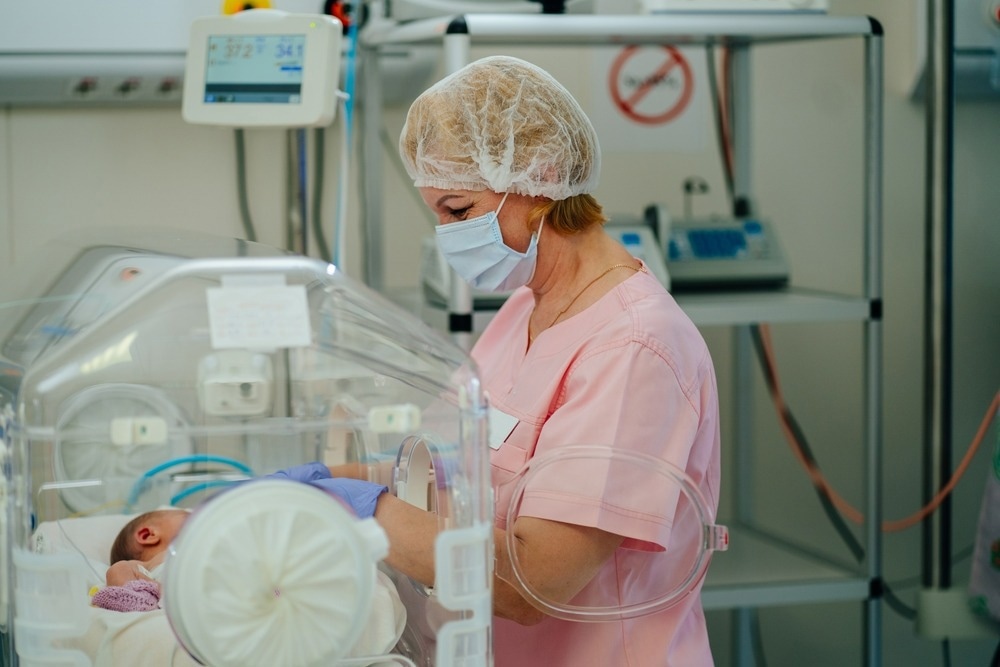In a recent study published in the Pediatrics journal, researchers assessed the epidemiology of neonatal coronavirus disease 2019 (COVID-19) infections.
 Study: Epidemiology of Neonatal COVID-19 in the United States. Image Credit: Iryna Inshyna/Shutterstock
Study: Epidemiology of Neonatal COVID-19 in the United States. Image Credit: Iryna Inshyna/Shutterstock
Background
Neonatal populations have lower rates of COVID-19 infection than adult and pediatric populations, presumably because of innate protective mechanisms. While newborns with symptoms may require intensive care unit (ICU) admission, most patients have satisfactory spontaneous breathing with minimal COVID-19 symptoms. Although uncommon, community-acquired COVID-19 in newborns is becoming more common due to highly transmissible emerging severe acute respiratory syndrome coronavirus 2 (SARS-CoV-2) variants.
About the study
In the present study, researchers explored the incidence, manifestation, and clinical outcomes of neonatal SARS-CoV-2 infections.
Retrospective neonatal data from the Cerner® Real-World Data were used in this cross-sectional study (CRWD). It consisted of clinical information, including demographics, interactions, illnesses, test results, and clinical events. More than 153 million people were included in the 2021 Q3 edition of CRWD, spanning all care settings and ages. Data related to newborns having a positive COVID-19 diagnosis between birth and 28 days after birth were extracted.
Data collection commenced with neonatal COVID-19 infections, which were used as a starting point. Neonates who tested positive for SARS-CoV-2 infection and were younger than 28 days were included. SARS-CoV-2 testing and coding for neonates were conducted in accordance with each particular health system's guidelines. The incidence of severe illness, regional distribution of infection, and the type of treatment administered were considered primary outcomes of interest. The incidence of COVID-19 infection in newborns in the US, as recorded within the CRWD, was the secondary outcome.
Cases that matched at least two of the following criteria were considered to have severe illnesses: (1) Cases having any of the following symptoms including fever, apnea, cough, tachypnea, or respiratory, vomiting or diarrhea, need for oxygen support, distress or recession; (2) any combination of the following among low white blood cell (WBC) count, low lymphocyte count, or elevated a high level of c-reactive protein (CRP); and (3) a questionable chest x-ray.
Pneumonia diagnosis was employed as a stand-in for an abnormal chest x-ray. Furthermore, comorbidities and demographic information were collected. Neonatal COVID-19 geographic distribution based on the patient's zip code prefix along with the consumption of medications including antivirals, antibiotics, corticosteroids, immunoglobulins, convalescent plasma (CCP), and inotropes/vasopressors was assessed.
Results
Between March 2020 and February 2021, 918 neonates were diagnosed with SARS-CoV-2 infection, including 77% who met the requirements for severe infection with COVID-19. The team noted that 3.40kg was the average weight of the neonates at admission, with the median age at hospital admission ranging between 11 to 22 days for all newborns and from 15 to 22 days for those with severe COVID-19. For all newborns, the median time to diagnosis was 14.5 days, and for those with severe infection, the same was 20 days. In the severe infection cohort, there was a larger percentage of newborns with low birth weight or early birth compared to the non-severe category.
Furthermore, comorbidities were more probable in neonates diagnosed with severe COVID-19. Almost 46.5% of those with severe COVID-19 had at least one comorbidity, with congenital abnormalities accounting for 38% of all cases and cardiac irregularities reported in 17% of cases. Possible sepsis was noted in 24%, biliary obstruction in 28.2%, and transfusion-needed anemia in 7.0% of the neonates.
Approximately 7.4% of newborns with mild COVID-19 were premature, and their birth weight ranged from 500 to 2499 g. Congenital abnormalities were noted in 25.5% of all neonates. Notably, 63.5% of newborns initially presented to the hospital had no symptoms and no evidence of infection. Tachypnea and fever were the most typical symptoms of infection, with 28.2% of infants experiencing severe COVID-19 infection having pneumonia. Furthermore, higher CRP levels were more probable in those with severe COVID-19, along with fewer platelets and lower albumin levels.
Conclusion
The study findings showed that while neonatal COVID-19 rates were low, severe presentations and death were rare. Few infants required respiratory assistance or additional therapy, while most were asymptomatic. Interestingly, the timing of the diagnosis suggested a nosocomial or community-acquired infection. The researchers believe it would be beneficial to examine how congenital disabilities affect COVID-19.